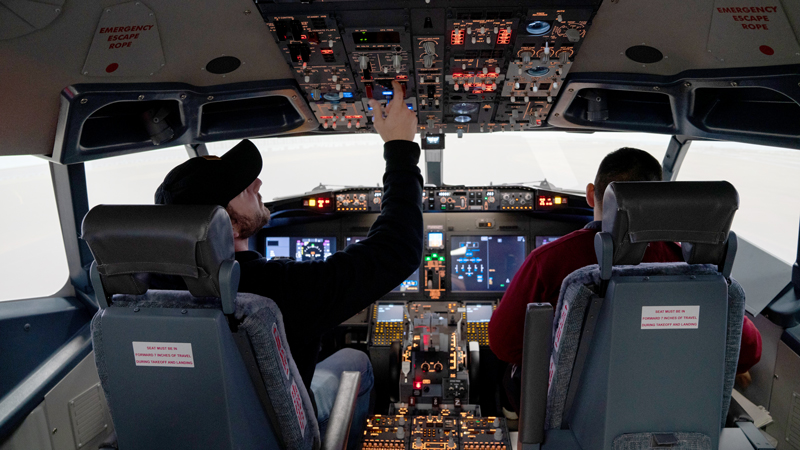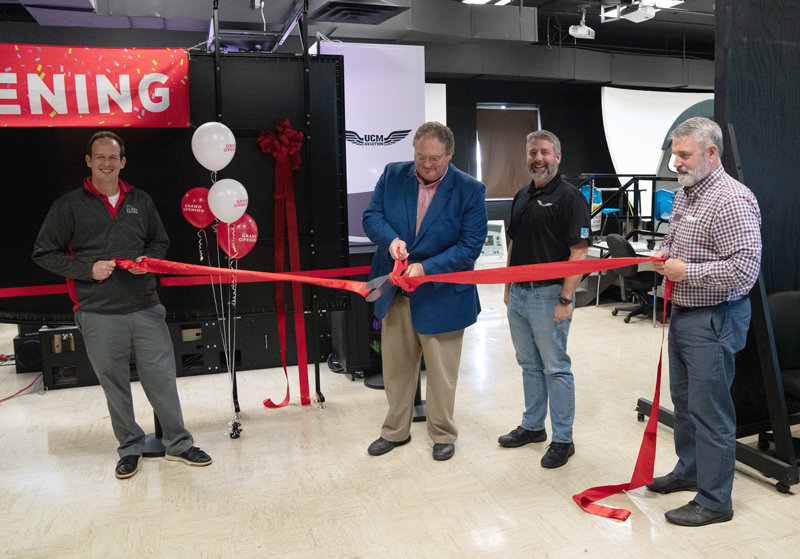By Jeff Murphy,
December 5, 2022

Senior University of Central Missouri students enrolled in the Professional Pilot
baccalaureate program, Jake White, left, and Juan Robles, both of St. Louis, gain
experience in the new Boeing 737 MAX Flight Training Device (FTD).
WARRENSBURG, MO – University of Central Missouri students who are preparing to become
professional pilots have a new opportunity to get training in the cockpit of a jet
aircraft long before they ever leave the ground. This opportunity is made possible
through the Department of Aviation’s recent acquisition of a new Boeing 737 MAX Flight
Training Device (FTD), installed this fall at the Raleigh T. Gaines Technology Building.
An informal ribbon-cutting ceremony to commemorate the arrival of the new equipment
was conducted in November by representatives of the aviation program and the Office
of the Provost and Vice President for Academic Affairs. The FTD is already being put
to use for advanced procedural, flight and systems training.
Action taken by the university’s Board of Governors in April 2022 made possible the
purchase of the FTD from Canadian company Flightdeck Solutions. This high-tech trainer
was purchased at a cost of approximately $355,000 to be paid over the next five years,
plus $29,980 for software/hardware maintenance.
Thanking Provost Phil Bridgmon for supporting the purchase, Matthew Furedy, chair
of the Department of Aviation, said the new FTD was a welcome addition to the professional
pilot training program. It replaces a Boeing 737 trainer that was obtained in 2008
but was no longer in use due to hardware and software issues. While the Departrment
of Aviation expected to retire the older FTD, a technician with Flightdeck Solutions
performed adjustments that are enabling UCM to continue using the older flight simulator
to accommodate additional training needs in the busy department.
“Flightdeck Solutions did a great job setting up the Boeing 737 MAX, and they got
the other one running about 90 percent,” Furedy said. “We’ve got a few more things
to be fixed on it, but we essentially went from not having one (FTD) to having two.”
Flightdeck Solutions has at least two decades of experience working with major aviation
colleges and universities across the nation. They have also been engaged with research
and development organizations such as Boeing, GE Aviation, NASA, and commercial airlines
such as Southwest, Air Canada, and Westjet.
The Boeing 737 MAX FTD has the layout of a transport category aircraft. Its flight
deck has authentic instruments, equipment, panels and controls that accurately represent
airliner standards that are critical to pilot training programs. The new FTD is equipped
with yokes/columns and rudder pedals that simulate real-life feedback, and fully functional
controls, switches and displays. Additionally, it has a large wraparound video screen
that is visible outside the cockpit glass, and beyond the nose of the FTD. This provides
the visuals needed to create a realistic experience for student pilots who embark
on virtual routes that take them across the country and beyond.

A ribbon-cutting event recognizing the acquisition of the Department of Aviation's
new Boeing 737 MAX Flight Training Device (FTD) was conducted recently by (left to
right) Andy Multer, assistant professor of aviation; Phil Bridgmon, provost and vice
president for academic affairs; Matthew Furedy, department chair; and David Jupp,
assistant professor of aviation.
Minutes before the recent ribbon cutting, senior professional pilot majors Juan Robles
and Jake White, both of St. Louis, were completing a simulated route under the instruction
of David Jupp, an assistant professor of aviation who was also a longtime professional
pilot. Both students shared their thoughts on the new equipment noting that the experience
draws student pilots in with such authenticity, sometimes they forget they are in
a simulator. This is despite the new FTD being a static device.
“It’s extremely immersive, White said. “One time during my last flight I was sitting
in the cockpit watching the screen and everything around me, then I realized the room
wasn’t moving.”
He added that with the exception of this device not having motion capabilities like
some multi-million dollar trainers, the new FTD provides a great learning opportunity
for students who want to become pilots.
Robles said the device is a way to put to use everything that is taught in other courses
related to topics such as pilot resource management, crew resource management, and
human factors associated with flying. He said in one training session, Rupp actually
brought in a small smoke machine to teach the flight crew how to deal with a smoke-in-the-cockpit
emergency situation.
“Having this dynamic introduced to us early gets you in the mindset of okay this is
what I’m going to have to do later on, in the right situation,” Robles remarked.
Learn more about UCM’s Department of Aviation and opportunities for professional pilot
training by clicking on the aviation website.